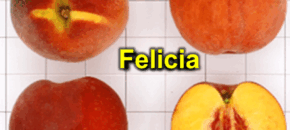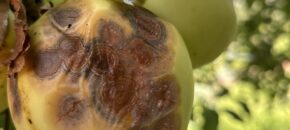Cucurbit powdery mildew (CPM), caused by Podosphaera xanthii, is one the most important diseases of cucurbit crops throughout the world. The pathogen is an obligate parasite, just like cucurbit downy mildew, meaning it needs a living host in order to survive. In northern regions that have a killing frost in the fall the pathogen will […]
Continue reading...Late July Peach Varieties for New Jersey – New and Standard

EVELYNN is a new, excellent, semi-free stone with a firm, yellow-fleshed peach variety. It is a low-acid, sweet to very sweet peach that ripens with Redhaven. Fruit is large, uniform, and has attractive, complete scarlet coloring, with smooth, low pubescence skin. It retains firmness on trees and during storage for longer than Redhaven, giving extra […]
Continue reading...Late-July Nectarine Varieties for New Jersey – New and Standard

BRIGANTINE is a new yellow-fleshed nectarine with semi-freestone, ripening July 20-25, just before ‘Summer Beaut’ and ‘Redhaven’. It has a full, glossy scarlet coloring with a slight golden-yellow background. Fruit skin is consistently free from blemishes. It has a nice, sweet, and acidic flavor, and firm, melting flesh. Flesh has traces of red. This is […]
Continue reading...Quick reviews of fungicide chemistries, FRAC groups, and fungicide resistance management
Did you know that first EBDC fungicide was registered for use in vegetable crops in 1964 followed by chlorothalonil in 1966. Historically speaking, the first New Jersey Vegetable Production Recommendations Guide was produced in 1969 and was only 33 pages long (it’s 502 pages now). Things have changed significantly over the past 55 years when […]
Continue reading...Identifying and controlling leaf mold in high tunnel & greenhouse tomato production
Leaf mold occasionally appears in high tunnel or greenhouse tomato production in New Jersey. However, under ideal conditions the disease will develop in field-grown crops. The fungus will cause infection under prolonged periods leaf wetness and when relative humidity remains above 85%. If relative humidity is below 85% the disease will not occur. Therefore, the […]
Continue reading...Fruit IPM Report July 29, 2025

Peach: Diseases: Brown rot: Brown rot is appearing in ripening fruit throughout the state. Highly effective rot materials such as DMI’s (FRAC group 3) and Strobilurins (FRAC group 11) should be applied beginning 3 – 4 weeks prior to harvest. See the NJ Commercial Tree Fruit Production Guide for more information. Tarnished Plant Bugs; and […]
Continue reading...